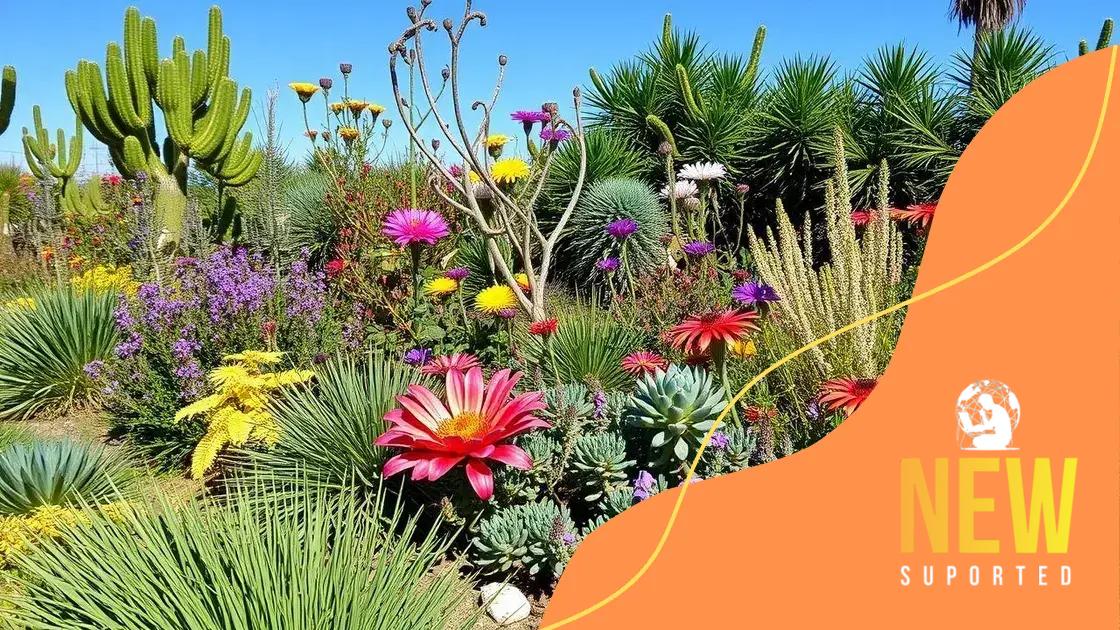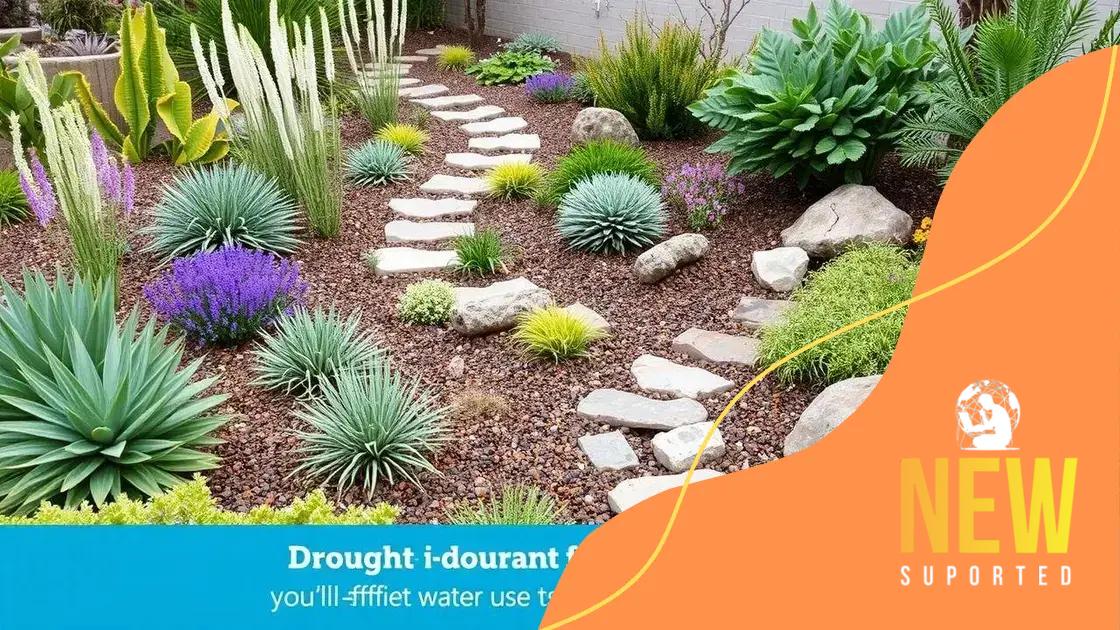How to create a water-efficient garden with drought-tolerant plants

Creating a water-efficient garden with drought-tolerant plants involves selecting suitable species, implementing smart designs, and using sustainable practices to conserve water while maintaining a beautiful outdoor space.
Are you curious about how to create a water-efficient garden with drought-tolerant plants? These gardens not only save water but also enhance your landscape. Let’s dive into the details to transform your outdoor space.
Understanding drought-tolerant plants
Understanding drought-tolerant plants is essential for creating a garden that thrives in dry conditions. These plants are adapted to survive with minimal water, making them perfect for sustainable gardening.
What Are Drought-Tolerant Plants?
Drought-tolerant plants include species that have evolved to withstand prolonged periods without water. They typically have deep root systems, thickened leaves, or other adaptations that conserve moisture.
Benefits of Using Drought-Tolerant Plants
Incorporating these plants into your garden provides several advantages:
- Saves water and reduces irrigation needs.
- Enhances biodiversity by supporting various wildlife.
- Reduces maintenance time and costs.
- Provides beautiful landscaping choices that are colorful and vibrant.
When selecting drought-tolerant plants, consider local climate and soil conditions to ensure success. Native plants are often the best choice, as they are already adapted to your specific environment. This means they require less care and resources, making them ideal for a water-efficient garden.
Additionally, combining different types of these plants can create a stunning visual display while minimizing water use. For instance, grouping plants with similar water needs can help manage watering schedules effectively. This practice not only conserves water but also allows for a more attractive and healthier garden overall.
Benefits of a water-efficient garden
A water-efficient garden offers numerous benefits that extend beyond saving water. By implementing smart gardening practices, you can enjoy a thriving outdoor space that is both beautiful and sustainable.
Environmental Benefits
Such gardens help to conserve valuable water resources, which is critical in times of drought. By using native and drought-tolerant plants, you can significantly reduce your water consumption and promote local ecosystems.
Cost Savings
Reducing water usage directly impacts your water bill. Additionally, water-efficient gardens often require less maintenance, leading to lower gardening costs over time. You’ll spend less on irrigation systems and plant replacement.
- Lower water bills due to reduced consumption.
- Less need for fertilizers and chemicals, as native plants thrive with minimal care.
- Fewer resources required for maintaining your garden.
Incorporating these practices not only supports your wallet but also encourages healthier plants. Healthy plants contribute to a more robust ecosystem and provide habitats for wildlife. By supporting pollinators and other beneficial insects, your garden can become a vibrant community space.
Moreover, water-efficient gardens provide aesthetic pleasure with unique designs. You can create attractive layouts that highlight the natural beauty of your chosen plants while ensuring sustainability. Imagine a garden filled with colorful native flowers and lush greenery, all thriving with minimal water. This visual appeal enhances your outdoor experience while contributing positively to the environment.
Designing your drought-resistant garden

Designing your drought-resistant garden involves selecting the right layout and plants to ensure beauty and efficiency. With careful planning, your garden can thrive with minimal water.
Garden Layout Considerations
Begin by assessing your space. Understanding sunlight patterns, soil type, and drainage are key. It helps in choosing the best location for different plants. Grouping plants based on their water needs is a smart approach. This way, you can water more efficiently, focusing on areas that need it most.
Selecting the Right Plants
Choose plants that are adapted to dry conditions. Some great options include:
- Lavender
- Sedum
- Agave
- California poppy
These plants not only conserve water but also bring color and texture to your garden. Mixing different types of plants creates visual interest. Incorporate various shapes and sizes for a dynamic look.
To maximize your garden’s aesthetic, think about colors, textures, and seasonal changes. Using stones, mulch, and other materials can enhance the design, retaining moisture while providing a stylish touch.
Your garden can also benefit from features like pathways and water-saving irrigation systems. Designing with these elements helps to create a functional space. Consider installing drip irrigation to minimize water loss and maintain healthy plants. This method targets the roots directly, ensuring they get the water they need without waste.
Maintenance tips for longevity
Maintaining your drought-resistant garden is crucial for its longevity and overall health. With a few simple tips, you can ensure that your plants thrive and continue to look beautiful.
Watering Techniques
Even drought-resistant plants require some water, especially during their establishment period. Water deeply and infrequently to encourage roots to grow deeper into the soil. This makes the plants more resilient to dry spells.
Mulching
Applying a layer of mulch around your plants can significantly help retain moisture in the soil. Organic mulches, like wood chips or straw, not only conserve water but also suppress weeds.
- Use 2-3 inches of mulch for the best results.
- Renew the mulch as it breaks down over time.
- Avoid piling mulch against plant stems to prevent rot.
Regularly check your plants for any signs of pests or diseases. Catching issues early helps to keep your garden healthy. If you notice problems, use organic pest control methods to protect your plants without harming the environment.
It’s also a good practice to prune your plants as needed. Removing dead or damaged foliage can promote better air circulation and reduce disease risk. Regular pruning encourages healthy growth and keeps your garden looking neat.
Finally, take time to observe your garden. Each season brings different challenges and opportunities. By understanding your plants’ needs, you can make adjustments that will help them flourish in your specific environment.
Additional resources for sustainable gardening
Exploring additional resources for sustainable gardening can enhance your knowledge and success in creating a vibrant, eco-friendly garden. Many guides, websites, and community programs provide invaluable information.
Online Resources
Countless websites are dedicated to sustainable gardening. Some great ones to check out include:
- Gardener’s Supply Company – a wealth of articles and tips on gardening practices.
- The Xerces Society – provides information on pollinator conservation.
- Native Plant Society – focuses on local and native plants for sustainability.
These sites offer practical advice on selecting plants, creating habitats, and using eco-friendly gardening practices. Videos and tutorials can provide visual guidance, making it easier to understand complex techniques.
Books and Publications
Reading books dedicated to sustainable gardening will deepen your understanding. Some recommended titles include:
- The Sustainable Vegetable Garden by John Jeavons
- Planting Native Plants by Richard H. Smith
- Gaia’s Garden: A Guide to Home-Scale Permaculture by Toby Hemenway
These resources cover essentials from soil health to designing a permaculture landscape. They provide a solid foundation for sustainable practices.
Additionally, local libraries often have resources on gardening. Visiting your library can offer access to a variety of books, magazines, and workshops.
Lastly, joining community gardening groups or local horticultural societies can connect you with fellow gardeners. Sharing experiences and tips can greatly enrich your knowledge. Participate in workshops or volunteer days to learn hands-on methods for sustainable practices.
FAQ – Frequently Asked Questions about Creating a Water-Efficient Garden
What are drought-tolerant plants?
Drought-tolerant plants are species that can survive long periods without water, making them ideal for sustainable gardening.
How can I design my garden to be water-efficient?
To design a water-efficient garden, group plants by their water needs, use mulch to retain moisture, and choose appropriate layouts.
What maintenance practices can help my drought-resistant garden thrive?
Regular watering, mulching, pruning, and checking for pests are essential maintenance practices to support your drought-resistant garden.
Where can I find additional resources for sustainable gardening?
You can find resources through gardening websites, local libraries, books on sustainable practices, and community gardening groups.






